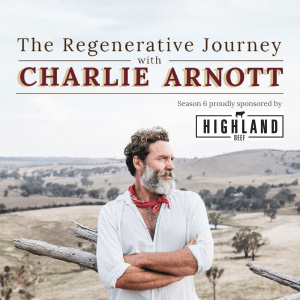
The Regenerative Journey with Charlie Arnott
Society & Culture:Personal Journals

Peter Andrews | The Godfather of Landscape Rehydration & Natural Sequence Farming
 2021-05-10
2021-05-10
Peter Andrews is one of Australia's landscape geniuses, who has been battling to change the stats quo attitude of government, farmers and land managers to hydrology and restoring landscape function for 40 years. Charlie sat with Peter at his farm in the central Tablelands of NSW while he recounted his formative years of desert life, how that informed his lifelong passion to restore the oldest continent in the world, and highlights that the healing of this land is totally within our reach if we reinstate a few simple principles of land management that had kept this landscape the most productive in the world.
Episode Takeaways:
There is a predictable natural sequence within the landscape we just have to recreate and nurture it | Peter’s property at Bungonia was bought to be a demonstration site, this region of NSW was a very over exploited area given its location between Sydney and Canberra | Plants are specialists at bringing various components and elements into a landscape | We don’t recreate the old landscape, we recreate the processes and function of the landscape | The landscape evolved due to plants managing water | Frequent fire, flood and drought are symptoms of a dysfunctional landscape | Peter grew up at Broken Hill where his experiences of desert storms and floods started him on his journey to rehydrate the landscape of Australia | Pioneering plants are essential to repair the landscapes | The current agricultural system that replies on the removal of specific plants is costing our farmers businesses and the landscapes health | Peter’s experience with sheep health in those early years identified the importance of nutrition and how a functioning landscape provides a broad range of plants to provide this nutrition | Over-stocked properties and poor understanding of hydrology has caused the degradation of the landscape | Early experiments on the family property at Broken Hill included ripping along the high water mark of food plains | The Australian landscape had a higher percentage of pines and palms than is currently there | We are generally left with fire recovery desert plants, mostly eucalypts | Water much more influential in the atmosphere than carbon | Hot air produced inland from a lack of transpiring vegetation and moving towards, and being absorbed by, the area over the moist ocean creates damaging weather events | Capillary action and gravity are the fundamental phenomena NSF relies upon to work | Fire flood and drought are opportunities to change the pattern and create plant succession | The Peter’s horses performance were results of the management of his land, where a fundamental principle was to let all plants grow | Willows are suckers in the landscape wounds that are creeks and rivers | Peter was able to double the aquatic life in riparian zones in 2 years using willows to heal them | 95mm dew can be accumulated in a year where ground cover is maintained | Restoring deciduous green trees in flow lines reduces fire risk | The eucalypts in the landscape before human management were huge, towering above the canopy and had the role of reducing the escape of moisture from the area | The best management post any fire is to spread seeds of deciduous shrub and tree species | It all gets back to human and environmental health and this is Peter’s motivation.
Episode Links:
Tarwyn Park Training
Australian Story ‘ Land Regeneration -Peter Andrews’ - 2017
TALS Institute - Peter’s ‘The Australian Landscape Science’ Institute
Dr. Jan Pokorny - Scientist
More Episodes
 2024-07-10
2024-07-10
 2024-05-15
2024-05-15
Create your
podcast in
minutes
- Full-featured podcast site
- Unlimited storage and bandwidth
- Comprehensive podcast stats
- Distribute to Apple Podcasts, Spotify, and more
- Make money with your podcast
It is Free
- Privacy Policy
- Cookie Policy
- Terms of Use
- Consent Preferences
- Copyright © 2015-2024 Podbean.com




